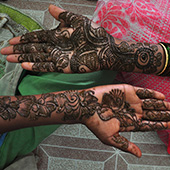Design Resource
Mehndi Art - Yadgiri, Karnataka
Hand Decorating Art
by
Prof. Bibhudutta Baraland Srikanth B.
Mehndi is an art of decorating hands, feet, or body by applying a henna paste. The powdered dry leaves of the henna plant (Lawsonia inermis), tea, lemon, and few drops of Eucalyptus oil is used while making a henna paste. After applying Mehndi, it is left overnight to get dry, and in the morning, it stains cherry-red to brown colour after washing. An ancient form of body art is still popular among Indian women, Africa, and the Middle East. The name Mehndi is derived from the Sanskrit word ‘mendhika’. The usage of this art is mentioned in the earliest Hindu Vedic ritual books. Applying mehndi is the most common tradition in rituals and ceremonies. It has initially been women’s practice though occasionally used for men. As time progressed, it was more common for women to wear it. In ancient times staining with mehndi paste was a Vedic custom.
No Indian wedding is complete without the Mehedi ceremony. A special event is organized for the ritual of the mehndi ceremony for the bride-to-be and her relatives. The ceremony is mainly held at the bride’s house on the eve of the marriage ceremony. The traditional Indian designs are made in the hands of the bride. The name or initials of the groom is hidden within the mehndi pattern, and the groom has to find out his name in the post-wedding ceremony. The women singing traditional songs and dancing, girls wearing colourful dresses create the celebratory festival feel. Mehndi, a highly antiseptic agent, protects the couple from viral diseases. It protects them from diseases that may occur just before the wedding, and this medicinal herb can lend a strong shield. Mehndi ceremony is not just a ritual; it reflects Indian culture. It is the combination of the knowledge of medicinal herbs with many lovely sentiments and beliefs.
This temporary form of body decoration not only adds beauty but also keeps the body cool. Earlier, a dot was applied to the palm of the hands, and it changed gradually to lines and other shapes. Today we see this elaboration became beautiful design patterns. Arabic mehndi designs, Indian mehndi designs, and Pakistani mehndi designs are the different types of mehndi designs. There are many variations and designs intricately made by artists. The patterns are created with plastic cones, syringes, toothpicks, and other tools. The art of Mehndi has existed for centuries. Henna is also used for hair dye and as a conditioner.




